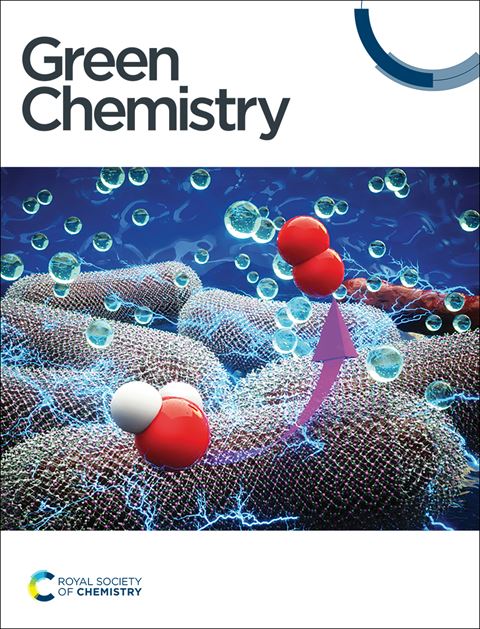在食品级溶剂中由三乙酸内酯可持续生产山梨酸钾†
IF 9.2
1区 化学
Q1 CHEMISTRY, MULTIDISCIPLINARY
引用次数: 0
摘要
以三乙酸内酯(TAL)为原料,利用食品级溶剂、乙醇(EtOH)和异丙醇(IPA)制备山梨酸钾(KS)。我们之前已经演示了以四氢呋喃(THF)为主要溶剂从TAL生产KS的途径,但使用四氢呋喃会带来环境和健康风险,特别是在食品应用中。该工艺在食品级溶剂中采用催化方法,包括三个主要步骤:氢化,醚化和水解,开环水解,从TAL生产KS。在由TAL合成KS的过程中,使用IPA比使用EtOH可以获得更高的收率和更短的反应时间。结果,IPA的总反应时间缩短至35.7 h,而我们之前使用THF和EtOH的研究为42.1 h,而TAL的KS收率可达84%。合成的KS具有反式-2和反式-4的几何构型,与市售KS相同。通过技术经济分析(TEA)和生命周期评估(LCA),我们估计利用IPA中开发的工艺从甘蔗中全面生产KS可以实现最低产品销售价格(MPSP)为每公斤8.27美元,范围为每公斤7.06-10.16美元[6000个蒙特卡罗模拟的第5 - 95个百分位数],碳强度(CI)为每公斤13.7[9.6-18.6]公斤二氧化碳当量。本研究强调使用食品级溶剂从TAL合成KS,与我们之前的研究(MPSP为9.68美元/千克[8.47-11.45美元/千克],CI为16.2[12.0-21.2]千克co2当量/千克)相比,显示出更高的经济可行性和环境可持续性,因为所需的总反应减少了,同时从TAL获得了相当的KS总产量。本文章由计算机程序翻译,如有差异,请以英文原文为准。
Sustainable potassium sorbate production from triacetic acid lactone in food-grade solvents†
This study advances the production of potassium sorbate (KS) from triacetic acid lactone (TAL) utilizing food-grade solvents, ethanol (EtOH) and isopropyl alcohol (IPA). We have previously demonstrated the route to produce KS from TAL in tetrahydrofuran (THF) as the main solvent, but the use of THF is associated with environmental and health risks especially for food applications. The process employs a catalytic approach in food-grade solvents and includes three main steps: hydrogenation, etherification and hydrolysis, and ring-opening hydrolysis to produce KS from TAL. In the synthesis of KS from TAL, the use of IPA leads to higher yields and reduced reaction times compared to EtOH. As a result, the overall reaction time in IPA was reduced to 35.7 h, compared to 42.1 h in our previous study using THF and EtOH, while achieving a comparable KS yield of 84% from TAL. The synthesized KS exhibits a trans-2, trans-4 geometrical configuration, identical to that of commercially available KS. Through techno-economic analysis (TEA) and life cycle assessment (LCA), we estimated full-scale production of KS from sugarcane with the developed process in IPA could achieve a minimum product selling price (MPSP) of $8.27 per kg with a range of $7.06–10.16 per kg [5th–95th percentiles from 6000 Monte Carlo simulations] and a carbon intensity (CI) of 13.7 [9.6–18.6] kg CO2-eq per kg. This study highlights the synthesis of KS from TAL using food-grade solvents, demonstrating improved economic viability and environmental sustainability compared to our previous research (MPSP of $9.68 per kg [$8.47–11.45 per kg] and CI of 16.2 [12.0–21.2] kg CO2-eq per kg), as the total required reaction decreases while achieving the comparable overall yield of KS from TAL.
求助全文
通过发布文献求助,成功后即可免费获取论文全文。
去求助
来源期刊

Green Chemistry
化学-化学综合
CiteScore
16.10
自引率
7.10%
发文量
677
审稿时长
1.4 months
期刊介绍:
Green Chemistry is a journal that provides a unique forum for the publication of innovative research on the development of alternative green and sustainable technologies. The scope of Green Chemistry is based on the definition proposed by Anastas and Warner (Green Chemistry: Theory and Practice, P T Anastas and J C Warner, Oxford University Press, Oxford, 1998), which defines green chemistry as the utilisation of a set of principles that reduces or eliminates the use or generation of hazardous substances in the design, manufacture and application of chemical products. Green Chemistry aims to reduce the environmental impact of the chemical enterprise by developing a technology base that is inherently non-toxic to living things and the environment. The journal welcomes submissions on all aspects of research relating to this endeavor and publishes original and significant cutting-edge research that is likely to be of wide general appeal. For a work to be published, it must present a significant advance in green chemistry, including a comparison with existing methods and a demonstration of advantages over those methods.
 求助内容:
求助内容: 应助结果提醒方式:
应助结果提醒方式:


